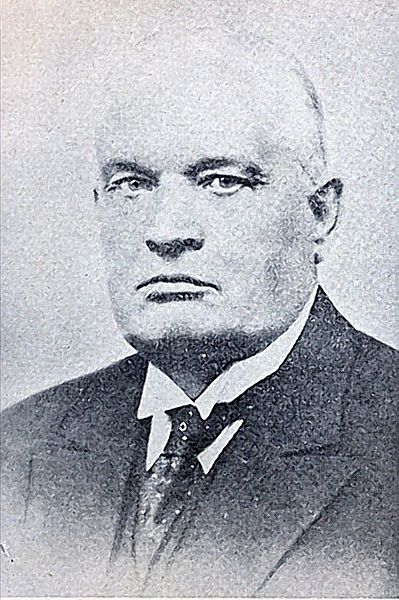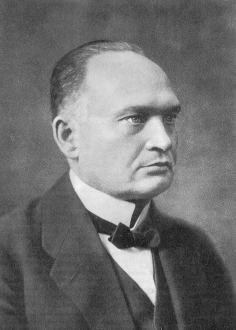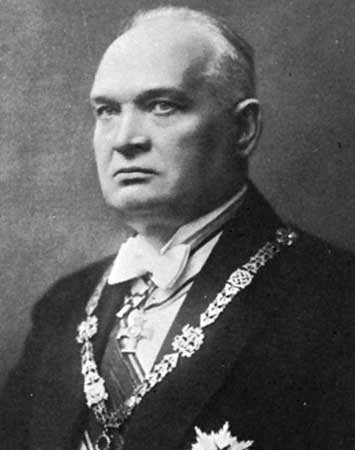<Back to Index>
- Mathematician Jean-Baptiste Morin, 1583
- Composer Georg Friedrich Händel, 1685
- First President of the Republic of Estonia Konstantin Päts, 1874



Konstantin Päts VR I/1 and III/1 (23 February 1874 – 18 January 1956) was a politician and the first President of Estonia.
Päts' surname, which means a loaf of bread in Estonian, came from an ancestor who was a miller by profession. The religion of his forefathers was Lutheranism, as for most Estonians, but his father Jakob Päts, a house builder, converted to Orthodoxy and married a Russian, Olga Tumanova.
In 1898, Päts graduated from the faculty of Law of Tartu University as Cand. jur. Later he received honorary doctorates from Tartu University, Tallinn Technical University and Andhra University, along with honorary membership of the Estonian Academy of Sciences.
Päts served in the Russian 96th Infantry Regiment of Omsk in Pskov and was promoted an ensign. From 1901 he worked as an editor of the "Teataja" newspaper in Tallinn. In 1904 he was the leader of the Estonian-Russian bloc in municipal elections in Tallinn, but declined the post of mayor of Tallinn due to not being ethnic Russian and became instead deputy mayor. He translated into Estonian several works about self-government and beekeeping.
He participated in the 1905 Revolution and was convicted in his
absence, having fled to Switzerland and then to Finland. He returned to
the Russian Empire in 1909 and served one year in a St. Petersburg prison. During his term he lost his spouse and never remarried. Konstantin Päts was one of the three members of the Salvation Committee that issued the Estonian Declaration of Independence on
24 February 1918. On the same day Päts was appointed Chairman of
the Council of Ministers and Minister of the Interior of the newly
proclaimed Republic of Estonia. Under the subsequent German occupation,
he was arrested by the German authorities and spent June to November in
a prison camp in Poland. After returning to Estonia he became the Prime
Minister and the Minister of War of the Provisional Government, in
which posts he served until 8 May 1919. Päts served several times as State Elder of Estonia: In 1922 Päts made the first Estonian state visit, to Finland. He had made a proposal for an Estonian-Finnish personal union in 1918, and he bore this idea also later in his mind, as testified by his so-called political testament, written in July 1940. Later, having befriended Finnish president Pehr Evind Svinhufvud, Päts made two more state visits to Finland, in 1935 and 1937. During
his whole political career he was an enthusiast and founder of
autonomous local and professional self-government bodies and vocational schools. Convinced
that the human lifespan is too short for ensuring a stable state
organization, from 1918 he began designing a framework of
self-government of various professional groups and ethnic minorities,
in order to found a well-balanced state based on proportional
representation and cooperation of such groups. He was Speaker of the Riigikogu from November 20, 1922 to June 7, 1923. Liberal
1920s were not favorable for such efforts, because proposals for
constitutional reform were rejected by the partial political
establishment. However, two professional self-governments (the Chamber
of Commerce and Chamber of Agriculture) and two cultural
self-governments of ethnic minorities (German and Jewish) were founded
during this period (until 1934). In the beginning of the 1930s, amidst economic and constitutional crisis, he was called by Kaarel Eenpalu to assume again political leadership of the state. He
presided over two more governments and was elected on 21 October 1933
to become the head of the transitional administration to the new,
presidential, constitution. In order to head off the seizure of power
by the proto-fascist Vaps Movement,
Konstantin Päts declared state of emergency in the whole country
(in certain parts this was already in effect immediately since 1918) on
12 March 1934, disbanding the Vaps movement and arresting its leading
figures. Konstantin Päts established a moderate regime that the
historian Georg von Rauch has called Authoritarian Democracy. In 1935 a
National Association was formed to replace political parties and series
of state corporative institutions were introduced. During
this time, many new buildings, mainly for new schools of all kinds and
for government and self-government institutions, and also bridges and
power plants were built. Regarding the constitution of 1934 too
dictatorial, he organised the passing of a new constitution through a
plebiscite and a National Constituent Assembly. During the transition
to his constitution he became Riigihoidja (President-Regent)
of Estonia on 3 September 1937 and President of the Republic, under the
new constitution, on 24 April 1938. His constitution was based on the
contemporary Polish and Belgian constitutions. He also admired the
British two-chamber parliament. This time was nostalgically remembered
as an era of independence, economic success and prosperity during the
following fifty years of Soviet occupation. Konstantin Päts's foreign policy was less successful. After the beginning of World War II he declared Estonian neutrality but was compelled to allow Soviet military bases in Estonia. Complete occupation and annexation by the Soviet Union followed next year. His successors in exile (Jüri Uluots and August Rei)
considered him the legal Estonian head of state and themselves as his
substitutes until his death. He was arrested and deported by the
Soviets and died in a psychiatric hospital in Kalinin (now
Tver) in 1956. Päts's forced psychiatric hospitalization was
justified by his "persistent claiming of being a president of Estonia".